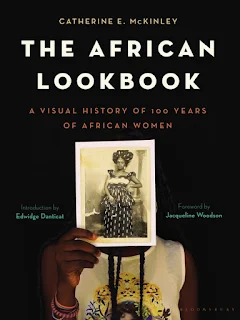The African Lookbook - A Visual History of 100 Years of African Women is a sampling of the photographs author Catherine E. McKinley has managed to collect from all around the world and includes some of the earliest photographs ever taken of African women.
However this isn't just a book of photographs to peruse. McKinley educates the reader along the way on the styles of photographs and portraits, the importance of the sitter's dress and fashion, the interest in African women and some of the undesirable attitudes of the intended recipients of many of the photographs featured.
"In European studios spanning the 1860s to 1970s, images of African women existed as a preponderance of exotica in 'women's work' - women nursing children, pounding food with mortar and pestle, selling on the street, carrying water, or posing in front of the 'primitive' home. Cameras fixated on breasts and hair, on body cicatrization, and the suggestive and even pornographic possibilities of rites of puberty, polygamy, and lightly disguised prostitution.
Many African photographers working at the same time would engage these tropes, as would later eras of African photographers (1950s - present), revisiting the images of a woman's back or skin or hairstyle but in a way that, however much a male gaze still mediated, the colonial gaze was removed." Page 31
"That gaze - that moment when the sitter meets the lens with the intent to author, or perhaps where coercion, or capitulation, or shyness or some other feeling is revealed - is what we look to for a countering narrative to the photographer's, or for assurance that the sitter still has the last word." Page 32I'll admit to wanting to see that in the eyes of many of the women photographed, a sense of power or pride and a sense the sitter wouldn't be exploited. A refusal to be dominated, their spirit free and intact. Unfortunately, I think I'm projecting a resoluteness that might not be there in order to make myself feel better about the vulnerability or poverty the sitter might have experienced. It's interesting to ponder though. Is the viewer projecting, or is the sitter really communicating something of their spirit and their inner most thoughts to us through the lens of the camera and down the decades?
I wasn't expecting the focus and accompanying commentary on fashion and what the women were wearing in the photographs and it took me by surprise.
"The history preserved in fashion can be more resilient and revealing than what is stored or memorialized in other kinds of repositories." Page 86Fashion throughout the decades encompassed the combination of traditional dress with styles that indicated a woman's background or religious beliefs and was invariably captured in the portraits (many unknown) obtained by the author and preserved in her collection.
I had little idea about the prominence of cloth and wrappers to African women, but learned that wrappers - referred to in the book as the 'foundation of African womanhood' on page 96 - are used for multiple purposes, including clothing, to carry a child, as currency, as a dowry, a shroud and sometimes even joined together to celebrate, protest or mourn. Some cloth designs are given a name and women or families might wear the same pattern to make a statement.
"Cloth that is beloved, that is named, is considered fine enough to be a dowry item, to be worn at weddings and funerals and baby-naming ceremonies, to become a 'heritage' item in a woman's cloth box and therefore a costly commodity for the ages, historically stored and respected like money, never devaluing over a woman's life-time." Page 92Already upset by the popularity of fast fashion in the 21st Century, this certainly gave me something to think about. If women from cultures around the world could aspire to this level of value and respect for cloth and quality made garments again (I'm thinking of 1500s here), imagine the impact around the world.
The African Lookbook by Catherine E. McKinley isn't what I expected. Yes, it's a Visual History of 100 Years of African Women, but I was disappointed not to see any of the photography of African women I observed as a child growing up in Australia in the 1970s-1980s. Stunning photographs of African women featured in National Geographic magazine, adorned in body paint, or wearing lip discs or gold neck rings and arm bands. An exotic beauty unmatched anywhere in the world gave rise to the fear of colonisation and a sorrow for the ruination of small tribes and villages still practising their way of life largely oblivious to the Western world.
I understand this book to be based on the author's painstaking collection of rare and precious photographs that otherwise might have been lost to time, but surely this era of colour photography shaped the worldwide view of African women and deserved to be included or commented on here. Looking at the blurb while writing this review, I note that the 100 year arc spans from 1870-1970 but I dearly wish it had been expanded to incorporate 150 years. It'd be hard to do so if the author's expertise and interest doesn't extend to the last 50 years, but the average reader has likely been exposed to this photography and it has influenced our views, rightly or wrongly.
While I didn't get what I was expecting, I certainly walked away with more than I bargained for. An introduction to the trade and importance of indigo - one of the most financially and culturally valuable commodities, used in makeup, hair dye, body paint, tattooing and more - for one.
The African Lookbook by Catherine E. McKinley is an informative read, and I longed to speak to the women featured in each of the photographs as I looked into their eyes and wondered about their lives; just as I imagine the author does.




































